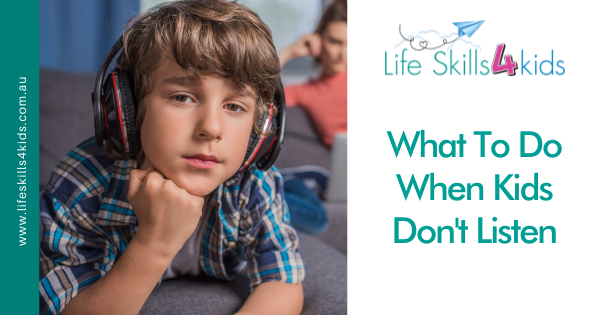When Kids Dont Listen
Written by Deb Hopper
Published in
Great Health Guide articles available in Audio:
How many parents complain that their kids don’t listen to what they are saying?
Kids not listening can be very frustrating for parents from day to day. There are many reasons why kids struggle to listen or pretend not to listen and many ways to reduce this frustration between parents and children.
Children might not respond in conversation for three main reasons:
1. They could be distracted especially by screens, TV, iPad, video game etc;
2. They have hearing or auditory processing difficulties; and
3. They are exhibiting a passive aggressive reaction or hidden anger towards the speaker, or anxiety about something happening.
Here are five tips for understanding and working with children when they are not listening or who pretend not to hear when you talk to them:
1. Decode the behaviour – distraction?
One of the first steps in understanding why a child may be pretending not to hear is to understand WHY they appear not to be listening. Are they simply distracted by watching TV, playing a game on the iPad, or reading a book? Is their attention elsewhere? Often, distraction is the reason why children appear not to respond to questions or instructions.
Tip: Before speaking, make sure you have a child’s active attention. Ask them to look at you, turn off the distraction if needed and ask them to repeat your question back to you, or at least say ‘OK Mum/Dad’.
2. Decode the behaviour – passive aggressive reaction?
Many children develop passive aggressive behaviours, which are one way for them to exert control over their environment (including people) when they may be feeling angry or anxious. This might look like when you call to him, he ignores you and makes you come upstairs to talk to him. It’s a way for children to have control over others, perhaps when they are feeling out of control or anxious. Kids not listening may be a sign that they aren’t coping and they are asking for help.
Tip: Sit and have a chat about what’s happening for them. Is there an assignment he is worried about or is she having difficulties with friends at school?
3. Make sure children have good boundaries.
Children feel safer when they have clear boundaries and expectations for behaviour at home and school. Have clear expectations for jobs around the house (even for toddlers). Ensure they understand the expectations for homework and even the tone of voice they use to speak to you. Children need to understand the rules of what is expected and the consequences of what will happen if these goals are not met. Children not listening may not have a good sense of boundaries (and therefore not feel safe) within themselves and their roles at home and/or school. Be gentle and loving, yet firm. If you talk about consequences stay firm in following through.
4. Keep instructions simple.
Many children, especially if they are young or have underlying learning difficulties, have trouble following too many directions at once. Break down your instructions or requests into smaller steps. Rather than asking them to put their clothes in their room, brush their teeth and put their lunch in their bag, ask them to do one activity at a time. If they understand and remember what to do, they won’t be overwhelmed by the request (sometimes resulting in feeling overwhelmed or anxious) and are more likely to respond verbally to your request. Kids not listening can sometimes be the brain being overwhelmed by instructions and shutting down, making it look like they are not listening.
Open-ended questions are invitations to say more and allow invitations for back and forth communication.
5. Monitor your tone of voice and ask open ended questions.
If your child is not listening, reduce distractions and communicate again with them being mindful that your voice is not raising in frustration or increasing in volume. Keep a calm and gentle voice. Once you have their attention ask open-ended questions rather than yes or no answer questions. Open-ended questions are invitations to say more and allows children to share their ideas and feelings while providing the opportunity for back and forth communication.
Children who are not listening or who appear to pretend not to hear can be very frustrating for both the adult and the child involved. The adult wants to communicate and must both understand where the child is at while keeping the routine moving. The child may be bothered by being interrupted from their favourite TV show or being interrupted in the middle of a game. This is very understandable.
The above five tips can help to increase understanding for adults about dynamics and reasons why kids may struggle to listen but also provides some easy to implement strategies for making life easier.
Are you looking for a way to help children reduce meltdowns?
Focus better in school?
Better understand their feelings, emotions and self-regulation?
If you are searching for the answer to these questions, you have found them in this book!
This book explains how the Just Right Kids Technique can help you to teach your child to understand, recognise and learn to control their emotions and behaviour.
Designed to fit into busy schedules, the concepts in the technique are easy to understand and the strategies can be implemented straight away. Through this fun, play-based approach to learning children will gain valuable life skills that will help them to feel ‘just right’ more of the time.



